University Case Study: Tourism in Machu Picchu, Peru Analysis
VerifiedAdded on 2020/04/15
|13
|2897
|150
Case Study
AI Summary
This case study examines the tourism landscape of Machu Picchu, a UNESCO World Heritage Site and one of the New Seven Wonders of the World. It begins with an overview of the site's history and significance, followed by an analysis of tourism visitation statistics, highlighting the rapid growth in tourist numbers since its discovery and the increasing importance of Machu Picchu as a top tourist destination in South America. The study then explores the destination's attractiveness through the lens of push and pull factors, identifying the cultural and historical significance of the Inca civilization as key motivators for tourists. An issue analysis delves into the challenges posed by growing tourism, including infrastructure weaknesses, socio-cultural issues, and environmental concerns, while also discussing the positive and negative impacts of tourism on the local community. The case study concludes with a discussion of policy implications, including measures taken by the Peruvian government to promote environmental awareness and sustainable tourism practices, such as limiting daily visitors and implementing guided tour regulations to preserve the site's integrity. This case study provides a comprehensive analysis of Machu Picchu's tourism, offering insights into the site's attractiveness, challenges, and the importance of sustainable tourism practices.
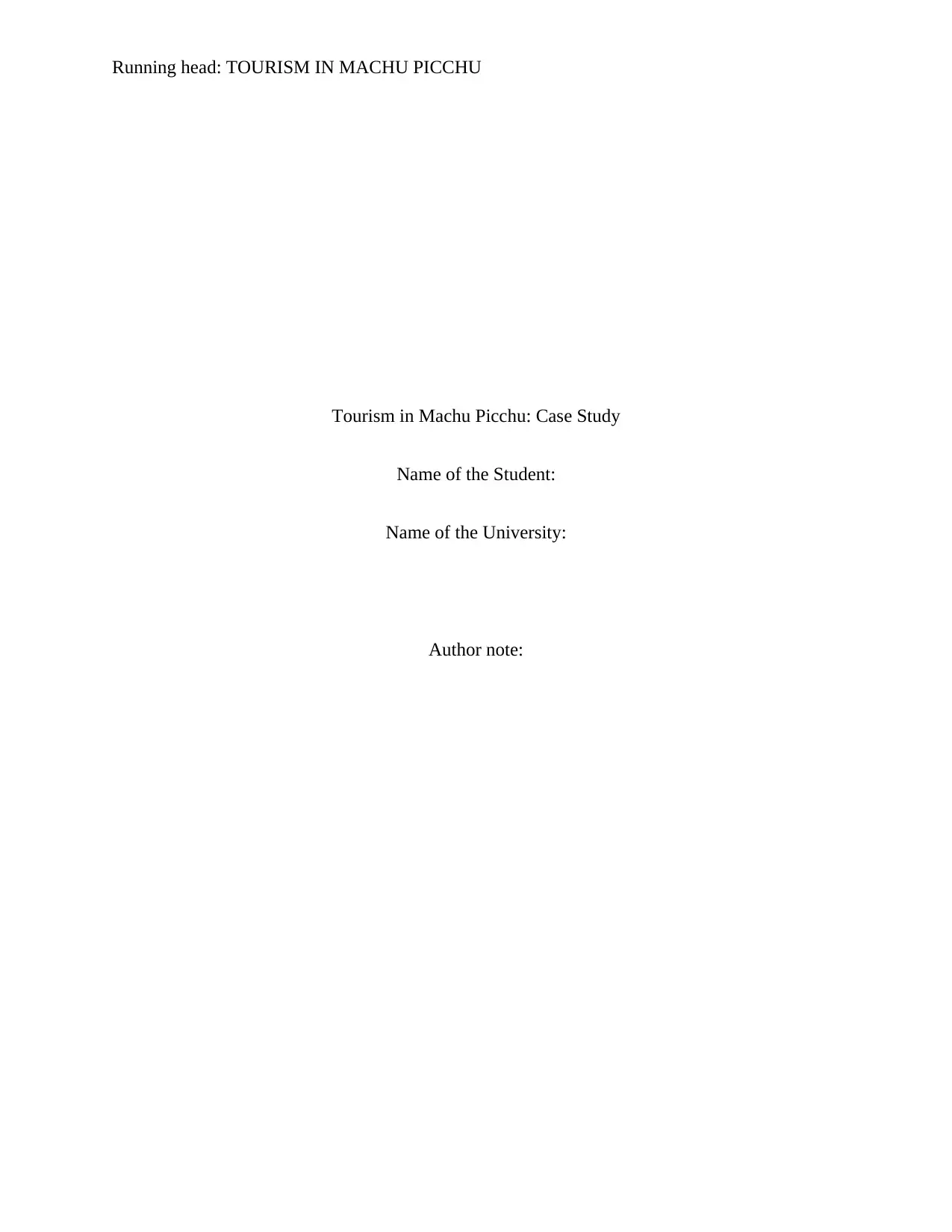
Running head: TOURISM IN MACHU PICCHU
Tourism in Machu Picchu: Case Study
Name of the Student:
Name of the University:
Author note:
Tourism in Machu Picchu: Case Study
Name of the Student:
Name of the University:
Author note:
Paraphrase This Document
Need a fresh take? Get an instant paraphrase of this document with our AI Paraphraser
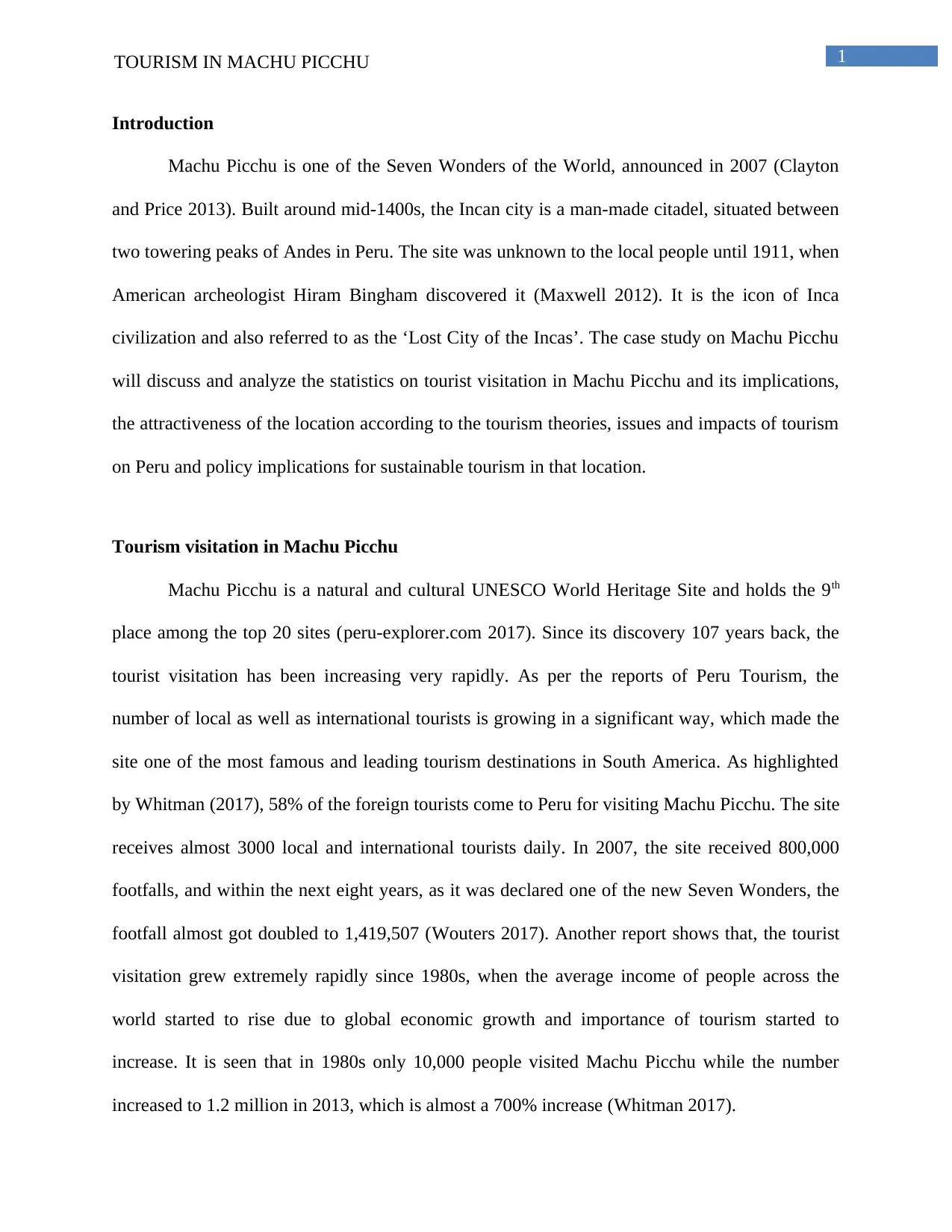
1TOURISM IN MACHU PICCHU
Introduction
Machu Picchu is one of the Seven Wonders of the World, announced in 2007 (Clayton
and Price 2013). Built around mid-1400s, the Incan city is a man-made citadel, situated between
two towering peaks of Andes in Peru. The site was unknown to the local people until 1911, when
American archeologist Hiram Bingham discovered it (Maxwell 2012). It is the icon of Inca
civilization and also referred to as the ‘Lost City of the Incas’. The case study on Machu Picchu
will discuss and analyze the statistics on tourist visitation in Machu Picchu and its implications,
the attractiveness of the location according to the tourism theories, issues and impacts of tourism
on Peru and policy implications for sustainable tourism in that location.
Tourism visitation in Machu Picchu
Machu Picchu is a natural and cultural UNESCO World Heritage Site and holds the 9th
place among the top 20 sites (peru-explorer.com 2017). Since its discovery 107 years back, the
tourist visitation has been increasing very rapidly. As per the reports of Peru Tourism, the
number of local as well as international tourists is growing in a significant way, which made the
site one of the most famous and leading tourism destinations in South America. As highlighted
by Whitman (2017), 58% of the foreign tourists come to Peru for visiting Machu Picchu. The site
receives almost 3000 local and international tourists daily. In 2007, the site received 800,000
footfalls, and within the next eight years, as it was declared one of the new Seven Wonders, the
footfall almost got doubled to 1,419,507 (Wouters 2017). Another report shows that, the tourist
visitation grew extremely rapidly since 1980s, when the average income of people across the
world started to rise due to global economic growth and importance of tourism started to
increase. It is seen that in 1980s only 10,000 people visited Machu Picchu while the number
increased to 1.2 million in 2013, which is almost a 700% increase (Whitman 2017).
Introduction
Machu Picchu is one of the Seven Wonders of the World, announced in 2007 (Clayton
and Price 2013). Built around mid-1400s, the Incan city is a man-made citadel, situated between
two towering peaks of Andes in Peru. The site was unknown to the local people until 1911, when
American archeologist Hiram Bingham discovered it (Maxwell 2012). It is the icon of Inca
civilization and also referred to as the ‘Lost City of the Incas’. The case study on Machu Picchu
will discuss and analyze the statistics on tourist visitation in Machu Picchu and its implications,
the attractiveness of the location according to the tourism theories, issues and impacts of tourism
on Peru and policy implications for sustainable tourism in that location.
Tourism visitation in Machu Picchu
Machu Picchu is a natural and cultural UNESCO World Heritage Site and holds the 9th
place among the top 20 sites (peru-explorer.com 2017). Since its discovery 107 years back, the
tourist visitation has been increasing very rapidly. As per the reports of Peru Tourism, the
number of local as well as international tourists is growing in a significant way, which made the
site one of the most famous and leading tourism destinations in South America. As highlighted
by Whitman (2017), 58% of the foreign tourists come to Peru for visiting Machu Picchu. The site
receives almost 3000 local and international tourists daily. In 2007, the site received 800,000
footfalls, and within the next eight years, as it was declared one of the new Seven Wonders, the
footfall almost got doubled to 1,419,507 (Wouters 2017). Another report shows that, the tourist
visitation grew extremely rapidly since 1980s, when the average income of people across the
world started to rise due to global economic growth and importance of tourism started to
increase. It is seen that in 1980s only 10,000 people visited Machu Picchu while the number
increased to 1.2 million in 2013, which is almost a 700% increase (Whitman 2017).
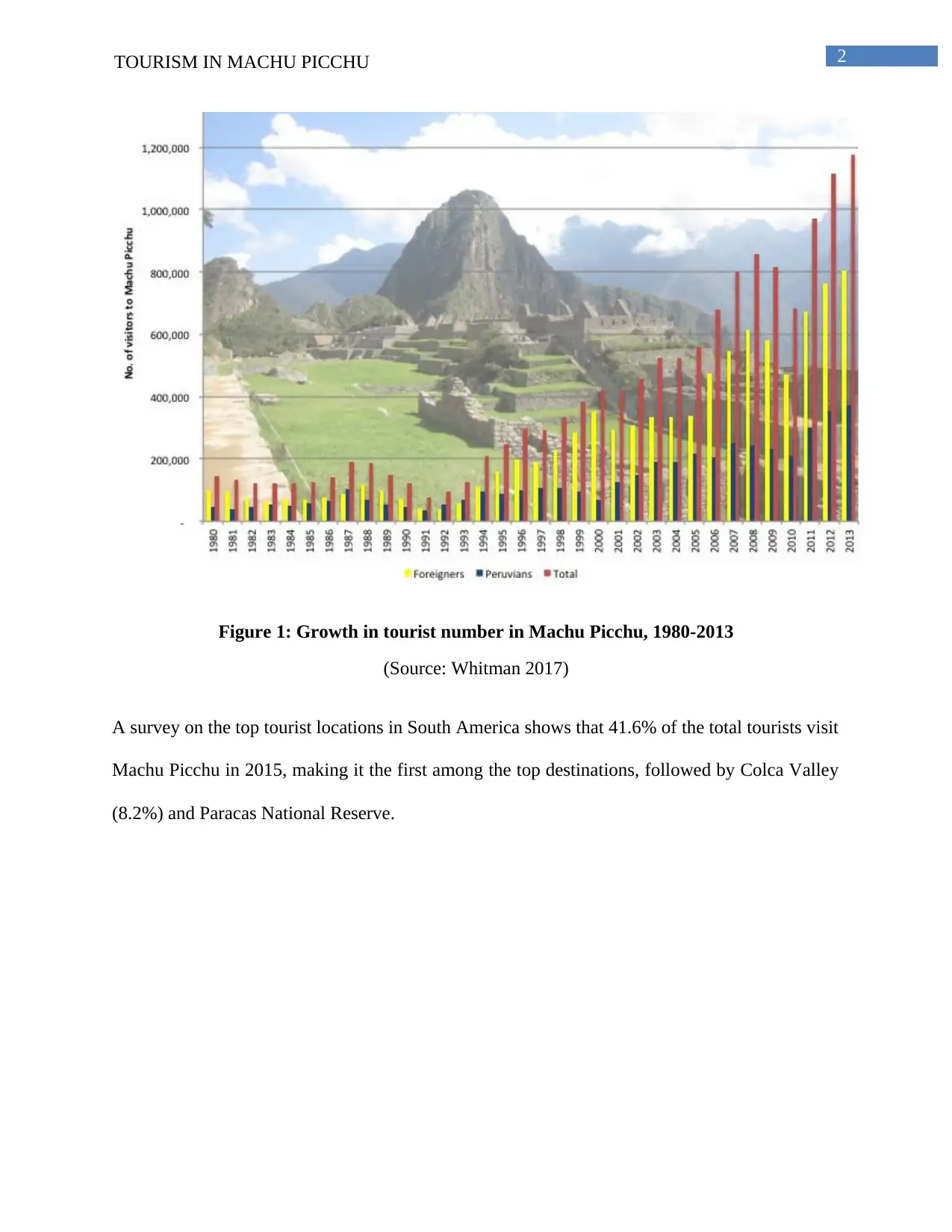
2TOURISM IN MACHU PICCHU
Figure 1: Growth in tourist number in Machu Picchu, 1980-2013
(Source: Whitman 2017)
A survey on the top tourist locations in South America shows that 41.6% of the total tourists visit
Machu Picchu in 2015, making it the first among the top destinations, followed by Colca Valley
(8.2%) and Paracas National Reserve.
Figure 1: Growth in tourist number in Machu Picchu, 1980-2013
(Source: Whitman 2017)
A survey on the top tourist locations in South America shows that 41.6% of the total tourists visit
Machu Picchu in 2015, making it the first among the top destinations, followed by Colca Valley
(8.2%) and Paracas National Reserve.
⊘ This is a preview!⊘
Do you want full access?
Subscribe today to unlock all pages.

Trusted by 1+ million students worldwide
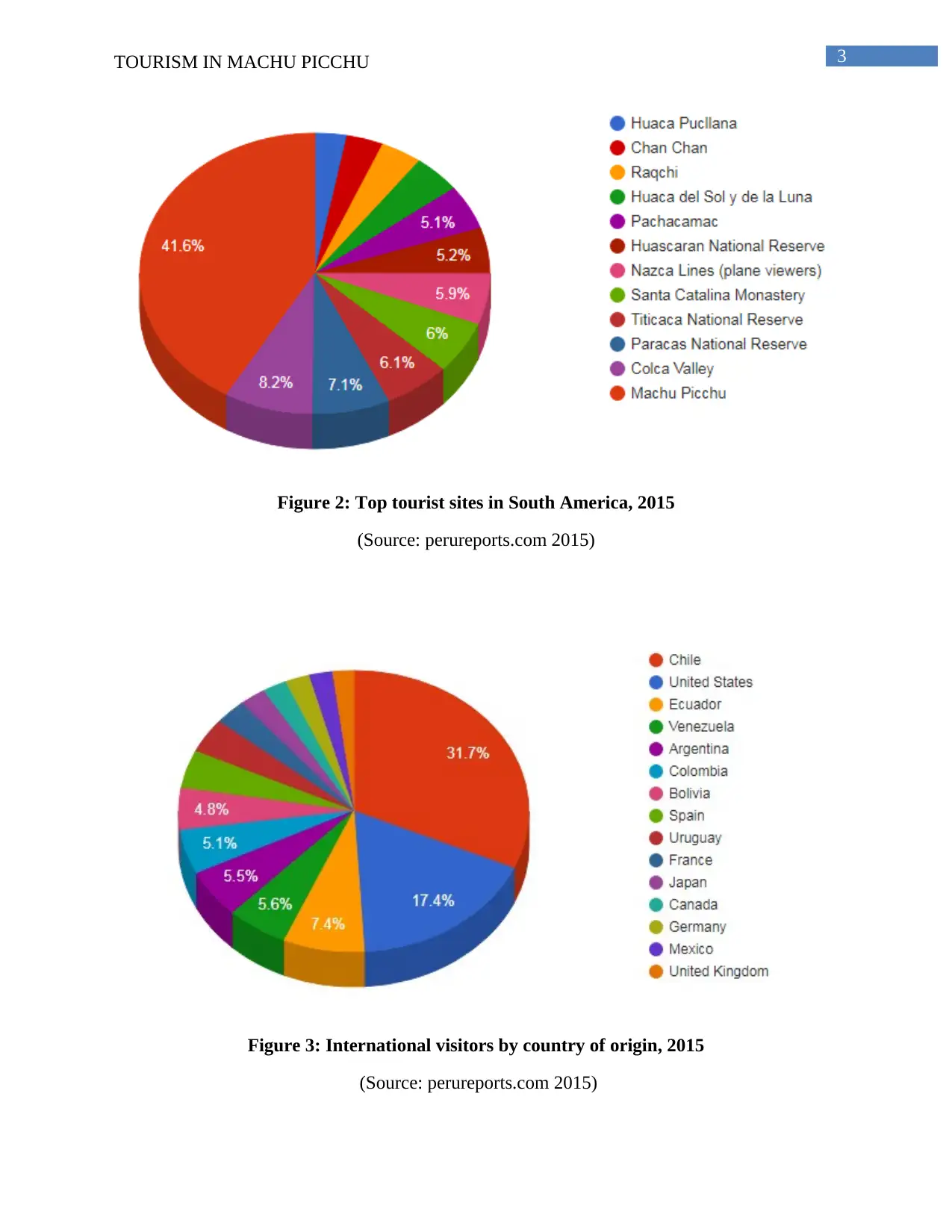
3TOURISM IN MACHU PICCHU
Figure 2: Top tourist sites in South America, 2015
(Source: perureports.com 2015)
Figure 3: International visitors by country of origin, 2015
(Source: perureports.com 2015)
Figure 2: Top tourist sites in South America, 2015
(Source: perureports.com 2015)
Figure 3: International visitors by country of origin, 2015
(Source: perureports.com 2015)
Paraphrase This Document
Need a fresh take? Get an instant paraphrase of this document with our AI Paraphraser
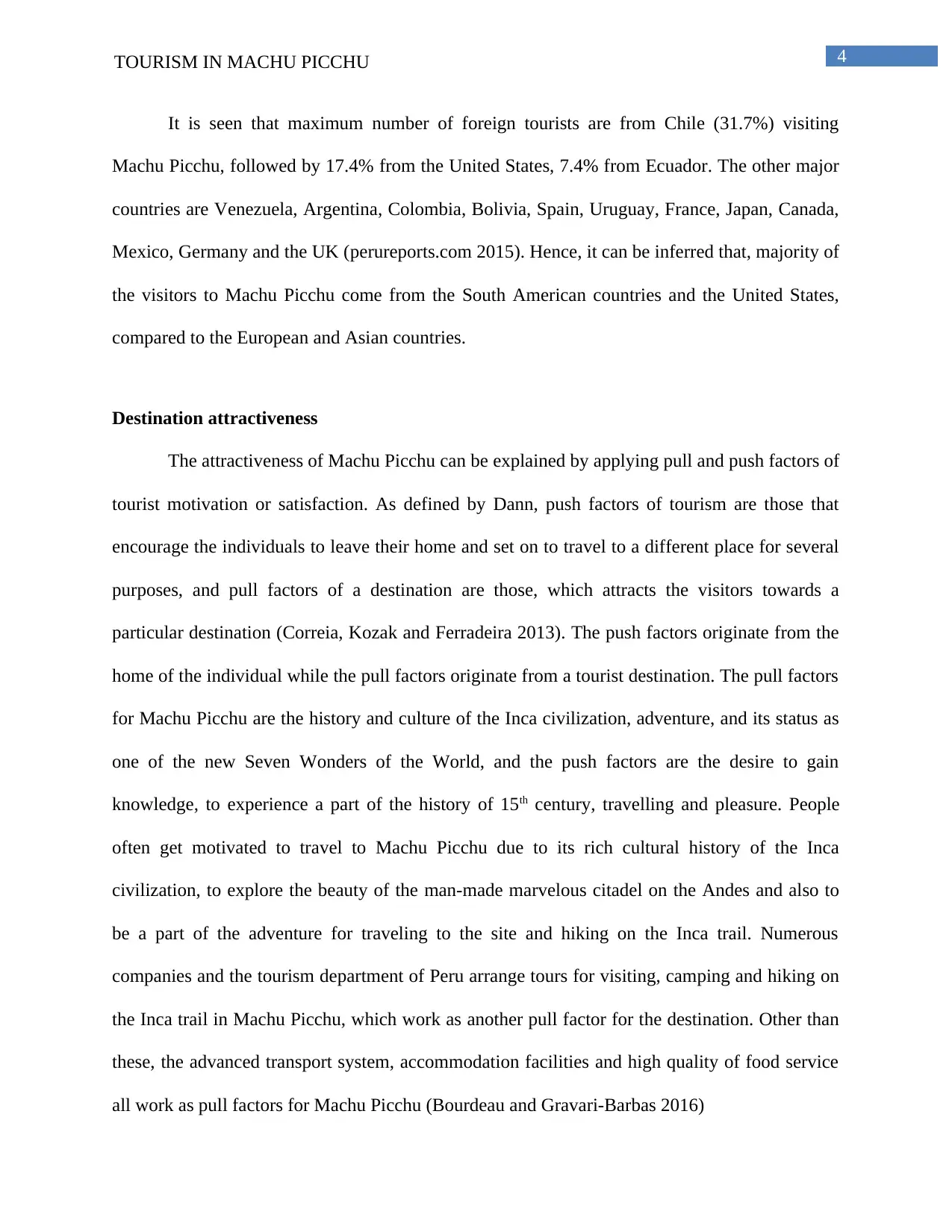
4TOURISM IN MACHU PICCHU
It is seen that maximum number of foreign tourists are from Chile (31.7%) visiting
Machu Picchu, followed by 17.4% from the United States, 7.4% from Ecuador. The other major
countries are Venezuela, Argentina, Colombia, Bolivia, Spain, Uruguay, France, Japan, Canada,
Mexico, Germany and the UK (perureports.com 2015). Hence, it can be inferred that, majority of
the visitors to Machu Picchu come from the South American countries and the United States,
compared to the European and Asian countries.
Destination attractiveness
The attractiveness of Machu Picchu can be explained by applying pull and push factors of
tourist motivation or satisfaction. As defined by Dann, push factors of tourism are those that
encourage the individuals to leave their home and set on to travel to a different place for several
purposes, and pull factors of a destination are those, which attracts the visitors towards a
particular destination (Correia, Kozak and Ferradeira 2013). The push factors originate from the
home of the individual while the pull factors originate from a tourist destination. The pull factors
for Machu Picchu are the history and culture of the Inca civilization, adventure, and its status as
one of the new Seven Wonders of the World, and the push factors are the desire to gain
knowledge, to experience a part of the history of 15th century, travelling and pleasure. People
often get motivated to travel to Machu Picchu due to its rich cultural history of the Inca
civilization, to explore the beauty of the man-made marvelous citadel on the Andes and also to
be a part of the adventure for traveling to the site and hiking on the Inca trail. Numerous
companies and the tourism department of Peru arrange tours for visiting, camping and hiking on
the Inca trail in Machu Picchu, which work as another pull factor for the destination. Other than
these, the advanced transport system, accommodation facilities and high quality of food service
all work as pull factors for Machu Picchu (Bourdeau and Gravari-Barbas 2016)
It is seen that maximum number of foreign tourists are from Chile (31.7%) visiting
Machu Picchu, followed by 17.4% from the United States, 7.4% from Ecuador. The other major
countries are Venezuela, Argentina, Colombia, Bolivia, Spain, Uruguay, France, Japan, Canada,
Mexico, Germany and the UK (perureports.com 2015). Hence, it can be inferred that, majority of
the visitors to Machu Picchu come from the South American countries and the United States,
compared to the European and Asian countries.
Destination attractiveness
The attractiveness of Machu Picchu can be explained by applying pull and push factors of
tourist motivation or satisfaction. As defined by Dann, push factors of tourism are those that
encourage the individuals to leave their home and set on to travel to a different place for several
purposes, and pull factors of a destination are those, which attracts the visitors towards a
particular destination (Correia, Kozak and Ferradeira 2013). The push factors originate from the
home of the individual while the pull factors originate from a tourist destination. The pull factors
for Machu Picchu are the history and culture of the Inca civilization, adventure, and its status as
one of the new Seven Wonders of the World, and the push factors are the desire to gain
knowledge, to experience a part of the history of 15th century, travelling and pleasure. People
often get motivated to travel to Machu Picchu due to its rich cultural history of the Inca
civilization, to explore the beauty of the man-made marvelous citadel on the Andes and also to
be a part of the adventure for traveling to the site and hiking on the Inca trail. Numerous
companies and the tourism department of Peru arrange tours for visiting, camping and hiking on
the Inca trail in Machu Picchu, which work as another pull factor for the destination. Other than
these, the advanced transport system, accommodation facilities and high quality of food service
all work as pull factors for Machu Picchu (Bourdeau and Gravari-Barbas 2016)
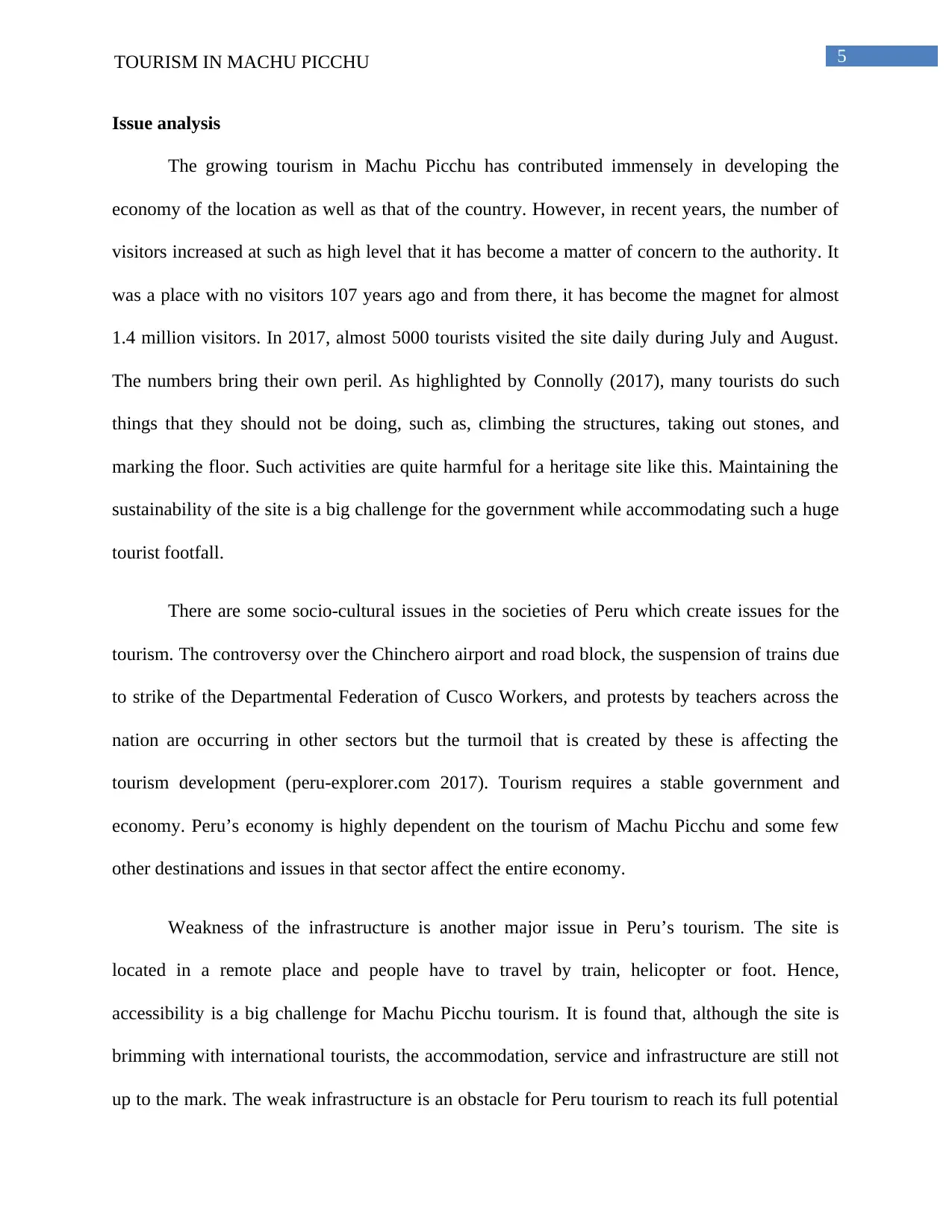
5TOURISM IN MACHU PICCHU
Issue analysis
The growing tourism in Machu Picchu has contributed immensely in developing the
economy of the location as well as that of the country. However, in recent years, the number of
visitors increased at such as high level that it has become a matter of concern to the authority. It
was a place with no visitors 107 years ago and from there, it has become the magnet for almost
1.4 million visitors. In 2017, almost 5000 tourists visited the site daily during July and August.
The numbers bring their own peril. As highlighted by Connolly (2017), many tourists do such
things that they should not be doing, such as, climbing the structures, taking out stones, and
marking the floor. Such activities are quite harmful for a heritage site like this. Maintaining the
sustainability of the site is a big challenge for the government while accommodating such a huge
tourist footfall.
There are some socio-cultural issues in the societies of Peru which create issues for the
tourism. The controversy over the Chinchero airport and road block, the suspension of trains due
to strike of the Departmental Federation of Cusco Workers, and protests by teachers across the
nation are occurring in other sectors but the turmoil that is created by these is affecting the
tourism development (peru-explorer.com 2017). Tourism requires a stable government and
economy. Peru’s economy is highly dependent on the tourism of Machu Picchu and some few
other destinations and issues in that sector affect the entire economy.
Weakness of the infrastructure is another major issue in Peru’s tourism. The site is
located in a remote place and people have to travel by train, helicopter or foot. Hence,
accessibility is a big challenge for Machu Picchu tourism. It is found that, although the site is
brimming with international tourists, the accommodation, service and infrastructure are still not
up to the mark. The weak infrastructure is an obstacle for Peru tourism to reach its full potential
Issue analysis
The growing tourism in Machu Picchu has contributed immensely in developing the
economy of the location as well as that of the country. However, in recent years, the number of
visitors increased at such as high level that it has become a matter of concern to the authority. It
was a place with no visitors 107 years ago and from there, it has become the magnet for almost
1.4 million visitors. In 2017, almost 5000 tourists visited the site daily during July and August.
The numbers bring their own peril. As highlighted by Connolly (2017), many tourists do such
things that they should not be doing, such as, climbing the structures, taking out stones, and
marking the floor. Such activities are quite harmful for a heritage site like this. Maintaining the
sustainability of the site is a big challenge for the government while accommodating such a huge
tourist footfall.
There are some socio-cultural issues in the societies of Peru which create issues for the
tourism. The controversy over the Chinchero airport and road block, the suspension of trains due
to strike of the Departmental Federation of Cusco Workers, and protests by teachers across the
nation are occurring in other sectors but the turmoil that is created by these is affecting the
tourism development (peru-explorer.com 2017). Tourism requires a stable government and
economy. Peru’s economy is highly dependent on the tourism of Machu Picchu and some few
other destinations and issues in that sector affect the entire economy.
Weakness of the infrastructure is another major issue in Peru’s tourism. The site is
located in a remote place and people have to travel by train, helicopter or foot. Hence,
accessibility is a big challenge for Machu Picchu tourism. It is found that, although the site is
brimming with international tourists, the accommodation, service and infrastructure are still not
up to the mark. The weak infrastructure is an obstacle for Peru tourism to reach its full potential
⊘ This is a preview!⊘
Do you want full access?
Subscribe today to unlock all pages.

Trusted by 1+ million students worldwide
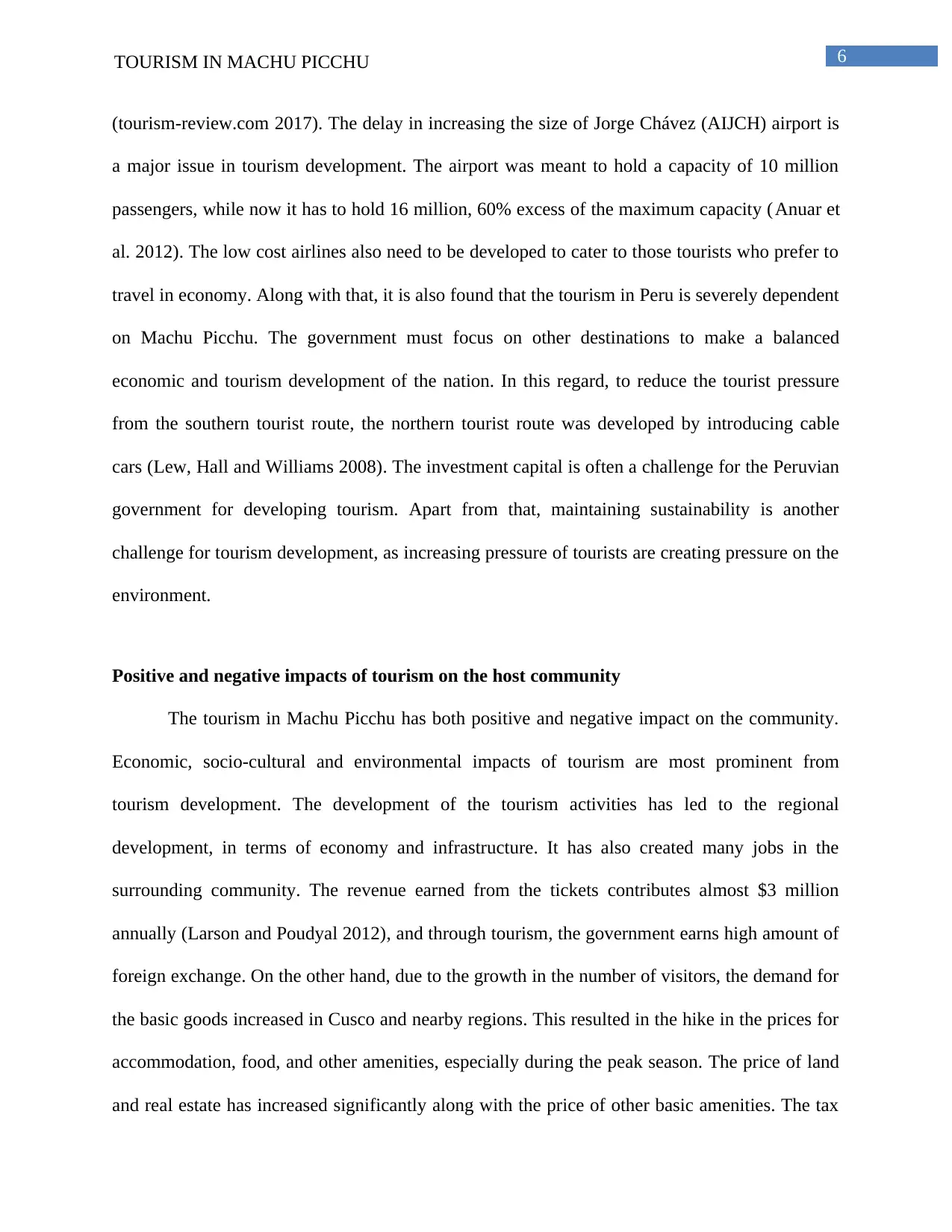
6TOURISM IN MACHU PICCHU
(tourism-review.com 2017). The delay in increasing the size of Jorge Chávez (AIJCH) airport is
a major issue in tourism development. The airport was meant to hold a capacity of 10 million
passengers, while now it has to hold 16 million, 60% excess of the maximum capacity (Anuar et
al. 2012). The low cost airlines also need to be developed to cater to those tourists who prefer to
travel in economy. Along with that, it is also found that the tourism in Peru is severely dependent
on Machu Picchu. The government must focus on other destinations to make a balanced
economic and tourism development of the nation. In this regard, to reduce the tourist pressure
from the southern tourist route, the northern tourist route was developed by introducing cable
cars (Lew, Hall and Williams 2008). The investment capital is often a challenge for the Peruvian
government for developing tourism. Apart from that, maintaining sustainability is another
challenge for tourism development, as increasing pressure of tourists are creating pressure on the
environment.
Positive and negative impacts of tourism on the host community
The tourism in Machu Picchu has both positive and negative impact on the community.
Economic, socio-cultural and environmental impacts of tourism are most prominent from
tourism development. The development of the tourism activities has led to the regional
development, in terms of economy and infrastructure. It has also created many jobs in the
surrounding community. The revenue earned from the tickets contributes almost $3 million
annually (Larson and Poudyal 2012), and through tourism, the government earns high amount of
foreign exchange. On the other hand, due to the growth in the number of visitors, the demand for
the basic goods increased in Cusco and nearby regions. This resulted in the hike in the prices for
accommodation, food, and other amenities, especially during the peak season. The price of land
and real estate has increased significantly along with the price of other basic amenities. The tax
(tourism-review.com 2017). The delay in increasing the size of Jorge Chávez (AIJCH) airport is
a major issue in tourism development. The airport was meant to hold a capacity of 10 million
passengers, while now it has to hold 16 million, 60% excess of the maximum capacity (Anuar et
al. 2012). The low cost airlines also need to be developed to cater to those tourists who prefer to
travel in economy. Along with that, it is also found that the tourism in Peru is severely dependent
on Machu Picchu. The government must focus on other destinations to make a balanced
economic and tourism development of the nation. In this regard, to reduce the tourist pressure
from the southern tourist route, the northern tourist route was developed by introducing cable
cars (Lew, Hall and Williams 2008). The investment capital is often a challenge for the Peruvian
government for developing tourism. Apart from that, maintaining sustainability is another
challenge for tourism development, as increasing pressure of tourists are creating pressure on the
environment.
Positive and negative impacts of tourism on the host community
The tourism in Machu Picchu has both positive and negative impact on the community.
Economic, socio-cultural and environmental impacts of tourism are most prominent from
tourism development. The development of the tourism activities has led to the regional
development, in terms of economy and infrastructure. It has also created many jobs in the
surrounding community. The revenue earned from the tickets contributes almost $3 million
annually (Larson and Poudyal 2012), and through tourism, the government earns high amount of
foreign exchange. On the other hand, due to the growth in the number of visitors, the demand for
the basic goods increased in Cusco and nearby regions. This resulted in the hike in the prices for
accommodation, food, and other amenities, especially during the peak season. The price of land
and real estate has increased significantly along with the price of other basic amenities. The tax
Paraphrase This Document
Need a fresh take? Get an instant paraphrase of this document with our AI Paraphraser
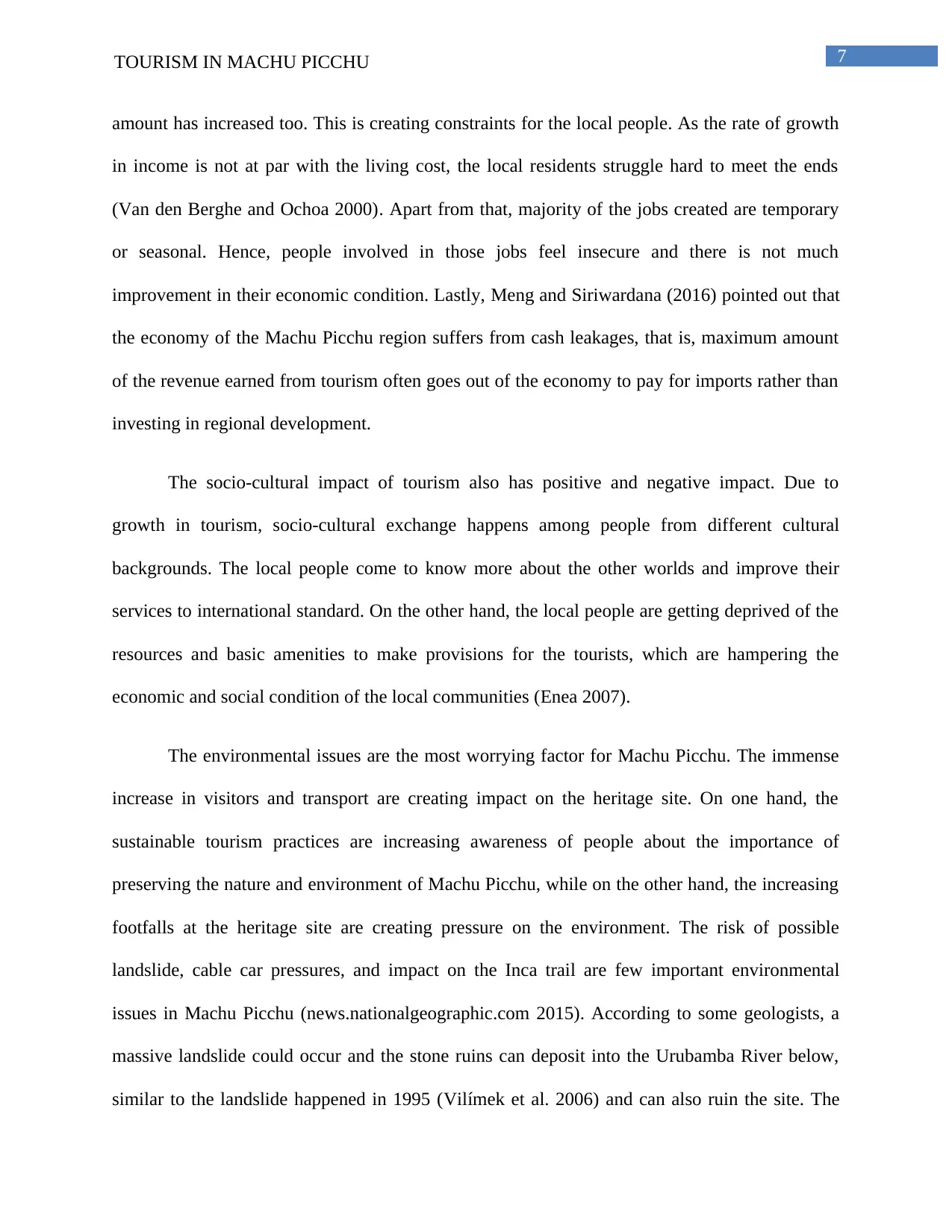
7TOURISM IN MACHU PICCHU
amount has increased too. This is creating constraints for the local people. As the rate of growth
in income is not at par with the living cost, the local residents struggle hard to meet the ends
(Van den Berghe and Ochoa 2000). Apart from that, majority of the jobs created are temporary
or seasonal. Hence, people involved in those jobs feel insecure and there is not much
improvement in their economic condition. Lastly, Meng and Siriwardana (2016) pointed out that
the economy of the Machu Picchu region suffers from cash leakages, that is, maximum amount
of the revenue earned from tourism often goes out of the economy to pay for imports rather than
investing in regional development.
The socio-cultural impact of tourism also has positive and negative impact. Due to
growth in tourism, socio-cultural exchange happens among people from different cultural
backgrounds. The local people come to know more about the other worlds and improve their
services to international standard. On the other hand, the local people are getting deprived of the
resources and basic amenities to make provisions for the tourists, which are hampering the
economic and social condition of the local communities (Enea 2007).
The environmental issues are the most worrying factor for Machu Picchu. The immense
increase in visitors and transport are creating impact on the heritage site. On one hand, the
sustainable tourism practices are increasing awareness of people about the importance of
preserving the nature and environment of Machu Picchu, while on the other hand, the increasing
footfalls at the heritage site are creating pressure on the environment. The risk of possible
landslide, cable car pressures, and impact on the Inca trail are few important environmental
issues in Machu Picchu (news.nationalgeographic.com 2015). According to some geologists, a
massive landslide could occur and the stone ruins can deposit into the Urubamba River below,
similar to the landslide happened in 1995 (Vilímek et al. 2006) and can also ruin the site. The
amount has increased too. This is creating constraints for the local people. As the rate of growth
in income is not at par with the living cost, the local residents struggle hard to meet the ends
(Van den Berghe and Ochoa 2000). Apart from that, majority of the jobs created are temporary
or seasonal. Hence, people involved in those jobs feel insecure and there is not much
improvement in their economic condition. Lastly, Meng and Siriwardana (2016) pointed out that
the economy of the Machu Picchu region suffers from cash leakages, that is, maximum amount
of the revenue earned from tourism often goes out of the economy to pay for imports rather than
investing in regional development.
The socio-cultural impact of tourism also has positive and negative impact. Due to
growth in tourism, socio-cultural exchange happens among people from different cultural
backgrounds. The local people come to know more about the other worlds and improve their
services to international standard. On the other hand, the local people are getting deprived of the
resources and basic amenities to make provisions for the tourists, which are hampering the
economic and social condition of the local communities (Enea 2007).
The environmental issues are the most worrying factor for Machu Picchu. The immense
increase in visitors and transport are creating impact on the heritage site. On one hand, the
sustainable tourism practices are increasing awareness of people about the importance of
preserving the nature and environment of Machu Picchu, while on the other hand, the increasing
footfalls at the heritage site are creating pressure on the environment. The risk of possible
landslide, cable car pressures, and impact on the Inca trail are few important environmental
issues in Machu Picchu (news.nationalgeographic.com 2015). According to some geologists, a
massive landslide could occur and the stone ruins can deposit into the Urubamba River below,
similar to the landslide happened in 1995 (Vilímek et al. 2006) and can also ruin the site. The
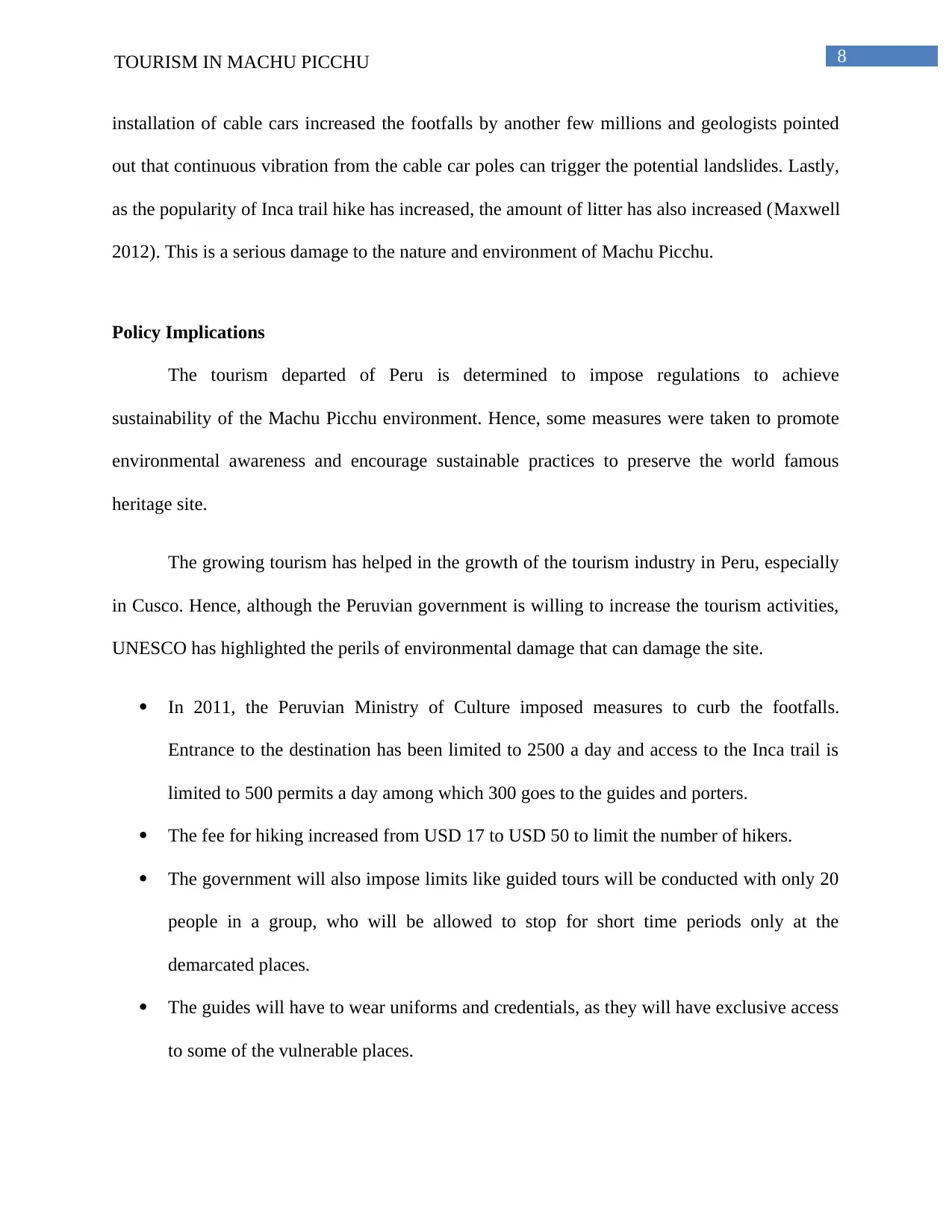
8TOURISM IN MACHU PICCHU
installation of cable cars increased the footfalls by another few millions and geologists pointed
out that continuous vibration from the cable car poles can trigger the potential landslides. Lastly,
as the popularity of Inca trail hike has increased, the amount of litter has also increased (Maxwell
2012). This is a serious damage to the nature and environment of Machu Picchu.
Policy Implications
The tourism departed of Peru is determined to impose regulations to achieve
sustainability of the Machu Picchu environment. Hence, some measures were taken to promote
environmental awareness and encourage sustainable practices to preserve the world famous
heritage site.
The growing tourism has helped in the growth of the tourism industry in Peru, especially
in Cusco. Hence, although the Peruvian government is willing to increase the tourism activities,
UNESCO has highlighted the perils of environmental damage that can damage the site.
In 2011, the Peruvian Ministry of Culture imposed measures to curb the footfalls.
Entrance to the destination has been limited to 2500 a day and access to the Inca trail is
limited to 500 permits a day among which 300 goes to the guides and porters.
The fee for hiking increased from USD 17 to USD 50 to limit the number of hikers.
The government will also impose limits like guided tours will be conducted with only 20
people in a group, who will be allowed to stop for short time periods only at the
demarcated places.
The guides will have to wear uniforms and credentials, as they will have exclusive access
to some of the vulnerable places.
installation of cable cars increased the footfalls by another few millions and geologists pointed
out that continuous vibration from the cable car poles can trigger the potential landslides. Lastly,
as the popularity of Inca trail hike has increased, the amount of litter has also increased (Maxwell
2012). This is a serious damage to the nature and environment of Machu Picchu.
Policy Implications
The tourism departed of Peru is determined to impose regulations to achieve
sustainability of the Machu Picchu environment. Hence, some measures were taken to promote
environmental awareness and encourage sustainable practices to preserve the world famous
heritage site.
The growing tourism has helped in the growth of the tourism industry in Peru, especially
in Cusco. Hence, although the Peruvian government is willing to increase the tourism activities,
UNESCO has highlighted the perils of environmental damage that can damage the site.
In 2011, the Peruvian Ministry of Culture imposed measures to curb the footfalls.
Entrance to the destination has been limited to 2500 a day and access to the Inca trail is
limited to 500 permits a day among which 300 goes to the guides and porters.
The fee for hiking increased from USD 17 to USD 50 to limit the number of hikers.
The government will also impose limits like guided tours will be conducted with only 20
people in a group, who will be allowed to stop for short time periods only at the
demarcated places.
The guides will have to wear uniforms and credentials, as they will have exclusive access
to some of the vulnerable places.
⊘ This is a preview!⊘
Do you want full access?
Subscribe today to unlock all pages.

Trusted by 1+ million students worldwide
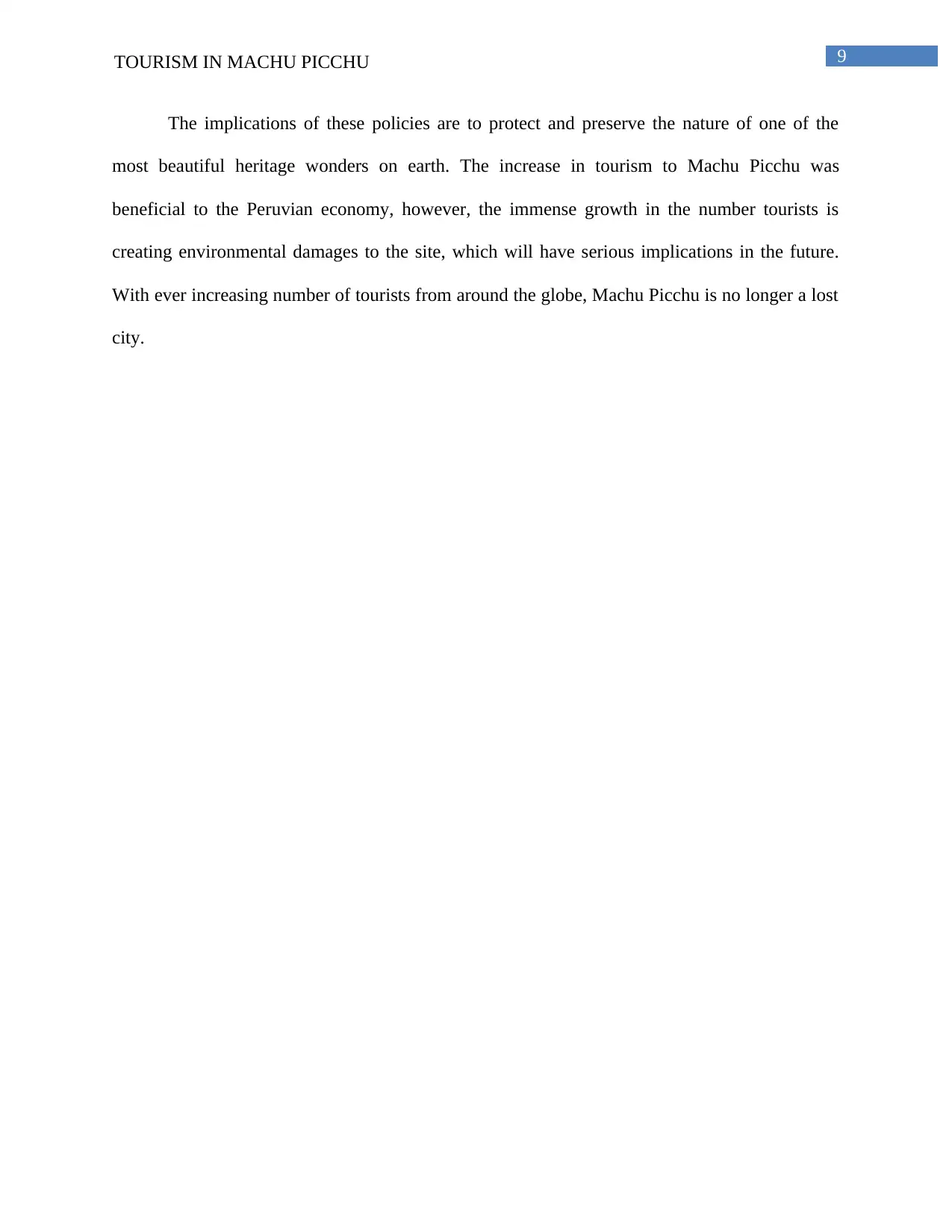
9TOURISM IN MACHU PICCHU
The implications of these policies are to protect and preserve the nature of one of the
most beautiful heritage wonders on earth. The increase in tourism to Machu Picchu was
beneficial to the Peruvian economy, however, the immense growth in the number tourists is
creating environmental damages to the site, which will have serious implications in the future.
With ever increasing number of tourists from around the globe, Machu Picchu is no longer a lost
city.
The implications of these policies are to protect and preserve the nature of one of the
most beautiful heritage wonders on earth. The increase in tourism to Machu Picchu was
beneficial to the Peruvian economy, however, the immense growth in the number tourists is
creating environmental damages to the site, which will have serious implications in the future.
With ever increasing number of tourists from around the globe, Machu Picchu is no longer a lost
city.
Paraphrase This Document
Need a fresh take? Get an instant paraphrase of this document with our AI Paraphraser
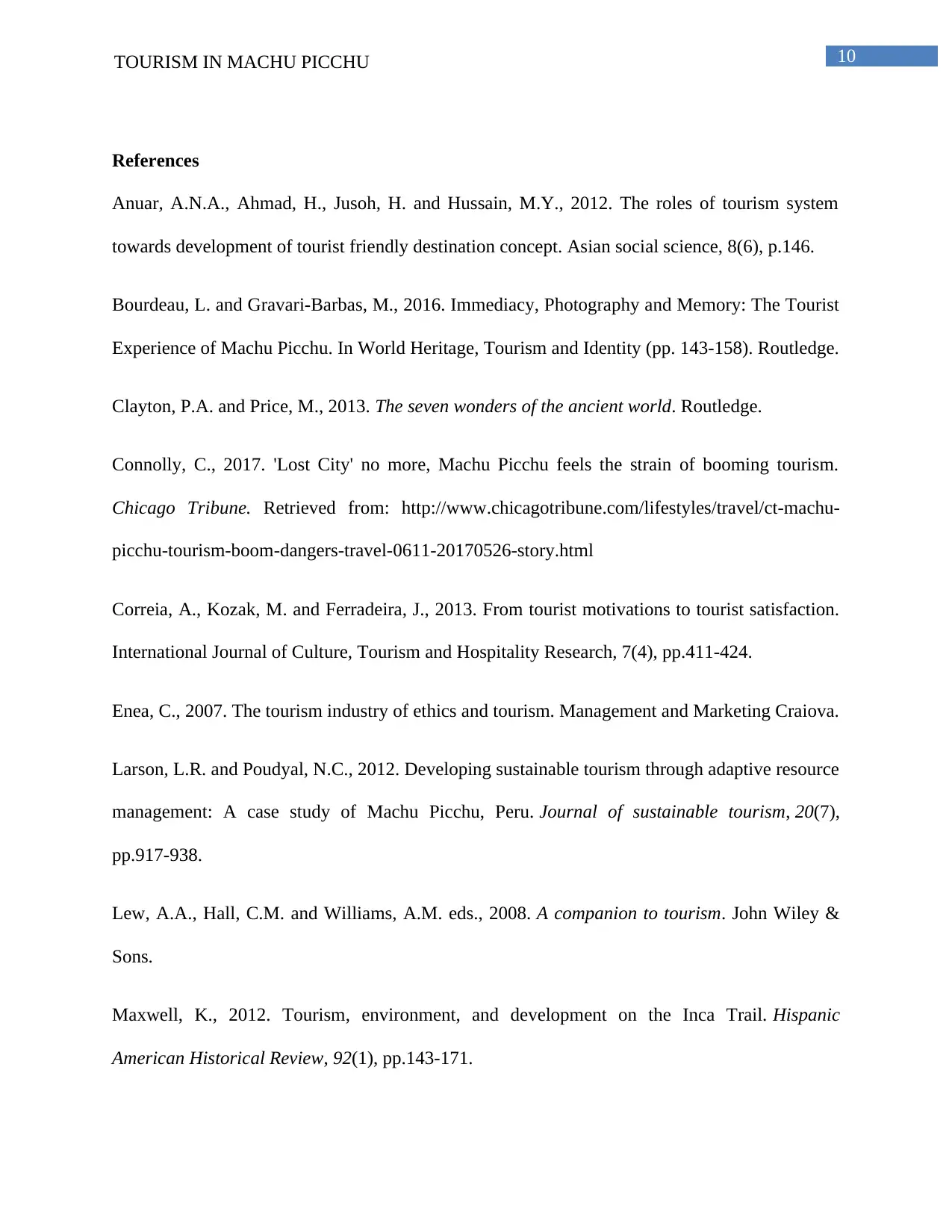
10TOURISM IN MACHU PICCHU
References
Anuar, A.N.A., Ahmad, H., Jusoh, H. and Hussain, M.Y., 2012. The roles of tourism system
towards development of tourist friendly destination concept. Asian social science, 8(6), p.146.
Bourdeau, L. and Gravari-Barbas, M., 2016. Immediacy, Photography and Memory: The Tourist
Experience of Machu Picchu. In World Heritage, Tourism and Identity (pp. 143-158). Routledge.
Clayton, P.A. and Price, M., 2013. The seven wonders of the ancient world. Routledge.
Connolly, C., 2017. 'Lost City' no more, Machu Picchu feels the strain of booming tourism.
Chicago Tribune. Retrieved from: http://www.chicagotribune.com/lifestyles/travel/ct-machu-
picchu-tourism-boom-dangers-travel-0611-20170526-story.html
Correia, A., Kozak, M. and Ferradeira, J., 2013. From tourist motivations to tourist satisfaction.
International Journal of Culture, Tourism and Hospitality Research, 7(4), pp.411-424.
Enea, C., 2007. The tourism industry of ethics and tourism. Management and Marketing Craiova.
Larson, L.R. and Poudyal, N.C., 2012. Developing sustainable tourism through adaptive resource
management: A case study of Machu Picchu, Peru. Journal of sustainable tourism, 20(7),
pp.917-938.
Lew, A.A., Hall, C.M. and Williams, A.M. eds., 2008. A companion to tourism. John Wiley &
Sons.
Maxwell, K., 2012. Tourism, environment, and development on the Inca Trail. Hispanic
American Historical Review, 92(1), pp.143-171.
References
Anuar, A.N.A., Ahmad, H., Jusoh, H. and Hussain, M.Y., 2012. The roles of tourism system
towards development of tourist friendly destination concept. Asian social science, 8(6), p.146.
Bourdeau, L. and Gravari-Barbas, M., 2016. Immediacy, Photography and Memory: The Tourist
Experience of Machu Picchu. In World Heritage, Tourism and Identity (pp. 143-158). Routledge.
Clayton, P.A. and Price, M., 2013. The seven wonders of the ancient world. Routledge.
Connolly, C., 2017. 'Lost City' no more, Machu Picchu feels the strain of booming tourism.
Chicago Tribune. Retrieved from: http://www.chicagotribune.com/lifestyles/travel/ct-machu-
picchu-tourism-boom-dangers-travel-0611-20170526-story.html
Correia, A., Kozak, M. and Ferradeira, J., 2013. From tourist motivations to tourist satisfaction.
International Journal of Culture, Tourism and Hospitality Research, 7(4), pp.411-424.
Enea, C., 2007. The tourism industry of ethics and tourism. Management and Marketing Craiova.
Larson, L.R. and Poudyal, N.C., 2012. Developing sustainable tourism through adaptive resource
management: A case study of Machu Picchu, Peru. Journal of sustainable tourism, 20(7),
pp.917-938.
Lew, A.A., Hall, C.M. and Williams, A.M. eds., 2008. A companion to tourism. John Wiley &
Sons.
Maxwell, K., 2012. Tourism, environment, and development on the Inca Trail. Hispanic
American Historical Review, 92(1), pp.143-171.
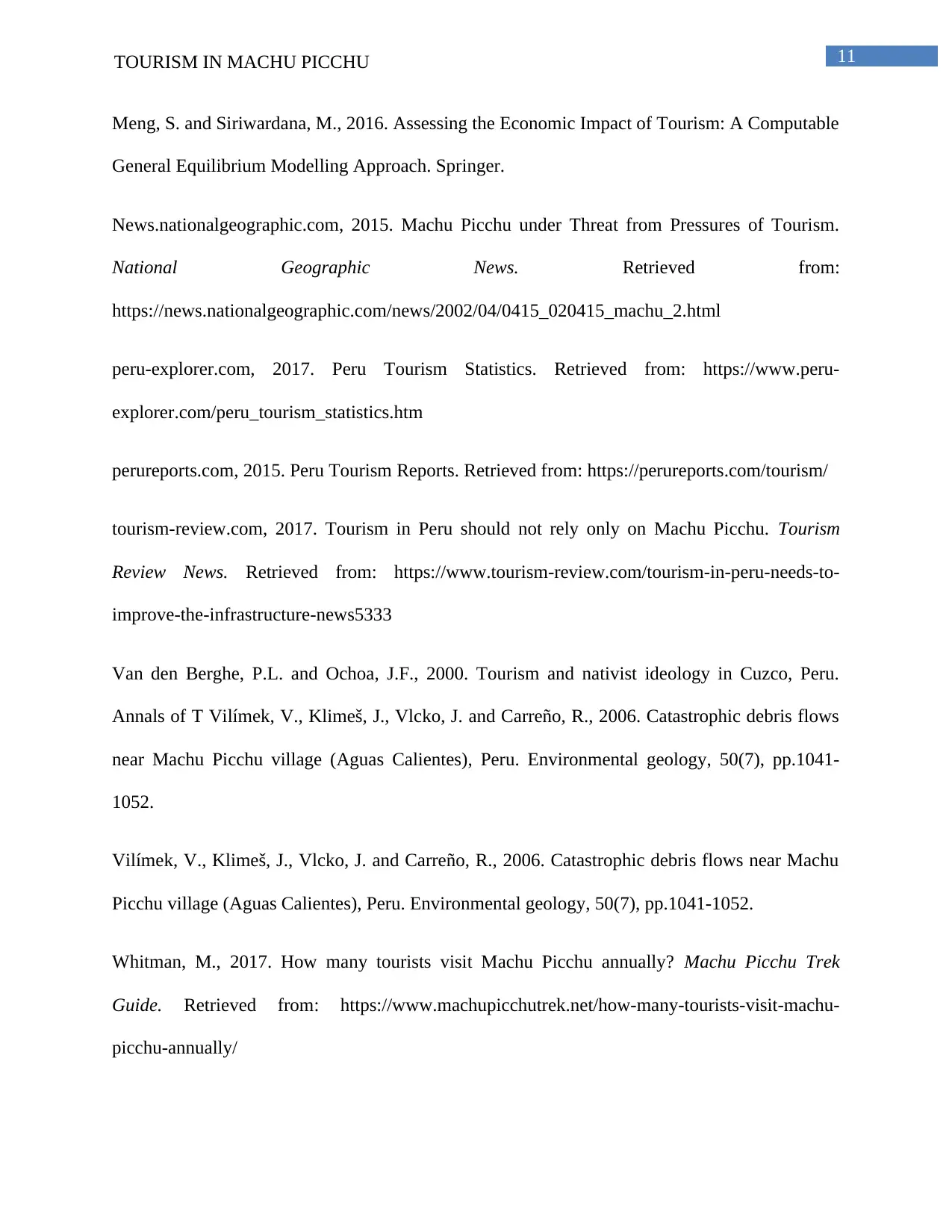
11TOURISM IN MACHU PICCHU
Meng, S. and Siriwardana, M., 2016. Assessing the Economic Impact of Tourism: A Computable
General Equilibrium Modelling Approach. Springer.
News.nationalgeographic.com, 2015. Machu Picchu under Threat from Pressures of Tourism.
National Geographic News. Retrieved from:
https://news.nationalgeographic.com/news/2002/04/0415_020415_machu_2.html
peru-explorer.com, 2017. Peru Tourism Statistics. Retrieved from: https://www.peru-
explorer.com/peru_tourism_statistics.htm
perureports.com, 2015. Peru Tourism Reports. Retrieved from: https://perureports.com/tourism/
tourism-review.com, 2017. Tourism in Peru should not rely only on Machu Picchu. Tourism
Review News. Retrieved from: https://www.tourism-review.com/tourism-in-peru-needs-to-
improve-the-infrastructure-news5333
Van den Berghe, P.L. and Ochoa, J.F., 2000. Tourism and nativist ideology in Cuzco, Peru.
Annals of T Vilímek, V., Klimeš, J., Vlcko, J. and Carreño, R., 2006. Catastrophic debris flows
near Machu Picchu village (Aguas Calientes), Peru. Environmental geology, 50(7), pp.1041-
1052.
Vilímek, V., Klimeš, J., Vlcko, J. and Carreño, R., 2006. Catastrophic debris flows near Machu
Picchu village (Aguas Calientes), Peru. Environmental geology, 50(7), pp.1041-1052.
Whitman, M., 2017. How many tourists visit Machu Picchu annually? Machu Picchu Trek
Guide. Retrieved from: https://www.machupicchutrek.net/how-many-tourists-visit-machu-
picchu-annually/
Meng, S. and Siriwardana, M., 2016. Assessing the Economic Impact of Tourism: A Computable
General Equilibrium Modelling Approach. Springer.
News.nationalgeographic.com, 2015. Machu Picchu under Threat from Pressures of Tourism.
National Geographic News. Retrieved from:
https://news.nationalgeographic.com/news/2002/04/0415_020415_machu_2.html
peru-explorer.com, 2017. Peru Tourism Statistics. Retrieved from: https://www.peru-
explorer.com/peru_tourism_statistics.htm
perureports.com, 2015. Peru Tourism Reports. Retrieved from: https://perureports.com/tourism/
tourism-review.com, 2017. Tourism in Peru should not rely only on Machu Picchu. Tourism
Review News. Retrieved from: https://www.tourism-review.com/tourism-in-peru-needs-to-
improve-the-infrastructure-news5333
Van den Berghe, P.L. and Ochoa, J.F., 2000. Tourism and nativist ideology in Cuzco, Peru.
Annals of T Vilímek, V., Klimeš, J., Vlcko, J. and Carreño, R., 2006. Catastrophic debris flows
near Machu Picchu village (Aguas Calientes), Peru. Environmental geology, 50(7), pp.1041-
1052.
Vilímek, V., Klimeš, J., Vlcko, J. and Carreño, R., 2006. Catastrophic debris flows near Machu
Picchu village (Aguas Calientes), Peru. Environmental geology, 50(7), pp.1041-1052.
Whitman, M., 2017. How many tourists visit Machu Picchu annually? Machu Picchu Trek
Guide. Retrieved from: https://www.machupicchutrek.net/how-many-tourists-visit-machu-
picchu-annually/
⊘ This is a preview!⊘
Do you want full access?
Subscribe today to unlock all pages.

Trusted by 1+ million students worldwide
1 out of 13
Related Documents
Your All-in-One AI-Powered Toolkit for Academic Success.
+13062052269
info@desklib.com
Available 24*7 on WhatsApp / Email
![[object Object]](/_next/static/media/star-bottom.7253800d.svg)
Unlock your academic potential
Copyright © 2020–2025 A2Z Services. All Rights Reserved. Developed and managed by ZUCOL.




